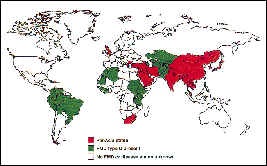Foot and Mouth Disease
Dr. Terry Whiting, Veterinary Services Branch
Foot and Mouth Disease Is the most infectious and costly disease known to animal Agriculture. Maintaining Manitoba as a region free without vaccination is essential to market access and rural sustainability.
Foot and Mouth Disease (FMD) of the PanAsia-O strain was identified in England on Feb 22rd, 2001 (multiple outbreaks); in Ireland (Single outbreak) March 6th, and in France departments of Mayenne and Orne (Single farm, March 13th). The disease is also confirmed in the Netherlands. The outbreaks can be traced from animal movements from the UK.
FMD is considered the most costly of all animal diseases. First, it is often necessary to conduct wholesale slaughter of animals wherever there is an outbreak. Second, no animals from an area not declared free of the disease may be moved to other locations or used in trade (including trade in semen) except as processed food subjected to high temperatures. It is also one of the most contagious. FMD is a viral disease that can infect all cloven-hoofed animals - cattle, goats, sheep, pigs, water buffalo, deer, bison, antelope, reindeer, llamas, chamois, alpacas, vicunas, giraffes, elephants, elk, camels.
There are seven sero-types of FMD virus (an apthovirus of the family Picornaviridae): A, O, C, Asia 1, and Southern African Territories (SAT) 1,2 and 3. And over 60 sub-types have been described.
Primarily infected animal movement and animal to animal contact spread the virus. The virus is durable in the environment and it can attach to truck tires and clothing and equipment in and be mechanically transmitted. Under the WTO countries impose severe restrictions on the trade in live animals or animal products which originate from regions of the world related to the assurance that the region is free from FMD.
North America has been successful in preventing the entry of FMD for many years with the last eradication program in Canada in 1952 (Saskatchewan).
The PanAsia-O Variant
In 1990 a new variant of FMD which came to be known as PanAsia-O emerged in northern India and spread first to the middle east through the trade of live animals for slaughter. This variant has successfully out competed other variants previously present in the Middle East and has spread as far as Turkey in 1996 and Greece in 2000. In addition to out-competing field strains of FMD the PanAsia-O variant has demonstrated an ability to cause disease in dairy cattle (Saudi Arabia) in spite of appropriate vaccination programs applied on a whole herd basis every 90 days.
The PanAsia-O has also moved into SE-Asia in 1997-2000, and into Mongolia 2000, Korea 2000, and Japan 2000. The Korean and Japan incursions have been eradicated. The PanAsia-O is a different strain from the 1997-Swine adapted strain, which wiped out the pork export markets of Taiwan. In spite of the high prevalence of vaccine use now in Taiwan the PanAsia-O strain has been isolated from the island in 2000.
Moving westward the PanAsia-O strain is the cause of the contained outbreak in South Africa in 2000, and the current UK outbreak.
The PanAsia-O strain has all the characteristics of being a particularly dangerous emerging pathogen of farm animals.
The International Office of Epizootics in Paris (OIE) has established a code with regard to foot-and-mouth disease and the measures which are necessary with regard to trade from countries affected by foot-and-mouth disease and practicing a non-vaccination policy. The WTO generally accepts the recommendations of the OIE as scientific fact in trade disputes. Such measures are first of all based on the principle of regionalisation, i.e. should only cover areas that are affected by foot-and-mouth disease and subject to restrictions and secondly in no case require any restrictions with regard to the trade in cereals.
In the EU the policy with regard to foot-and-mouth disease is based on non-vaccination and regionalisation in case of an outbreak. For the time being the measures with regard to the UK cover the totality of the country and the case of France are limited to the French departments of Mayenne and Orne. The Netherlands has undertaken a regionalised vaccination program. The EU has the interest more than any other country to control, eradicate and avoid the spread of foot-and-mouth disease to other parts of the EU in addition to avoiding the spread to third countries.
Foot-and-mouth disease legislation in the EU does not impose any restrictions on trade in cereals except from areas affected or under restriction, which are subject to stringent movement controls.
In Canada the lead agency in prevention, diagnosis and response to a FAD threat is the Canadian Food Inspection Agency. Recent computer simulation exercises carried out in Ontario and Alberta revealed some deficiencies in preparedness. Provinces not asked to participate in this simulation are not currently fully informed.
| Country | Date of identification |
| Cambodia | Jan 2000 |
| Iran | May-Jul 2000 |
| Japan | Mar-May 2000 |
| Malaysia | Feb 2000 |
| Mongolia | May-Jun 2000 |
| Nepal | Jun 2000 |
| Russia | Apr 2000 |
| South Africa | Sep-Nov 2000 |
| South Korea | Mar-Apr 2000 |
| Taiwan | Jan-Feb 2000 |
| Thailand | Jan 2000 |
| Turkey | Jan 2000 |
| UAE | May 2000 |
| UK | Feb-Mar 2001 |
Table and Figure Identification of PanAsian-O strain worldwide in 2000. Source: Nick J. Knowles Dept. of Exotic Diseases R&D Institute for Animal Health Pirbright Laboratory Ash Road, Pirbright Woking, Surrey, GU24 0NF, UK


